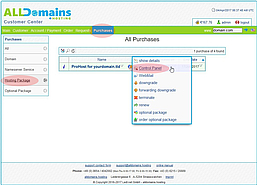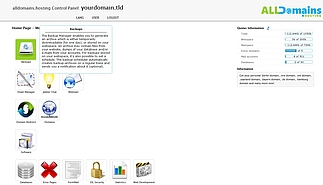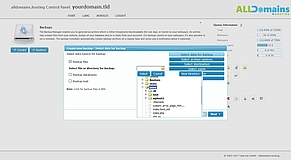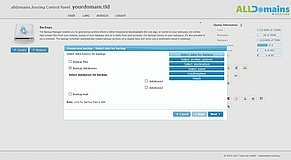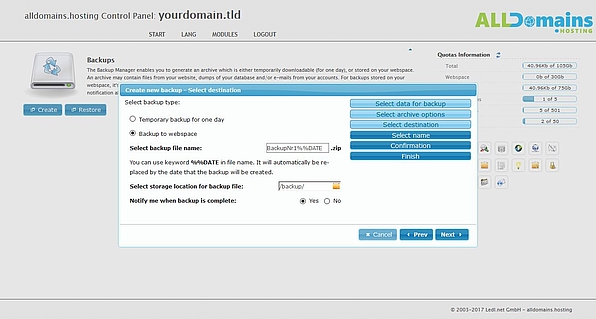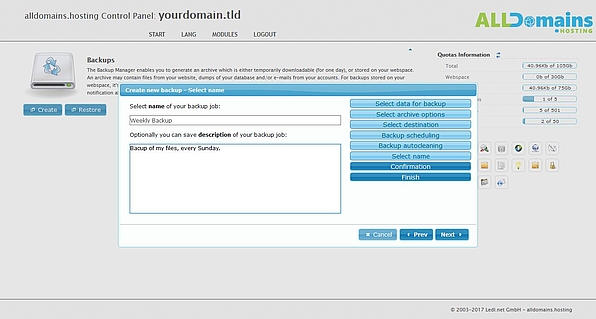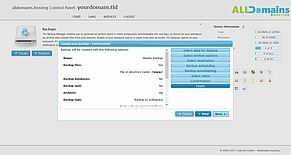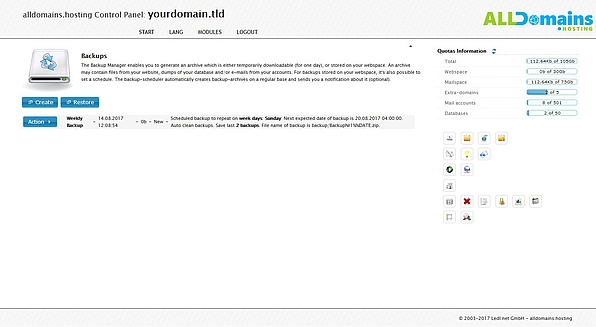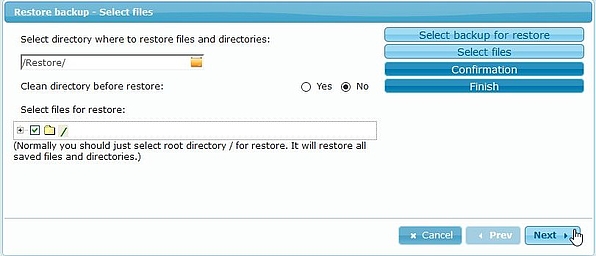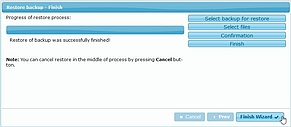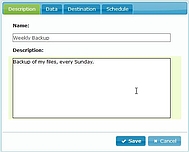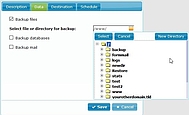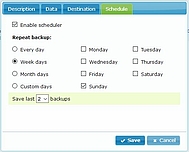Backups
![[Translate to English:] cpicon_backup](/fileadmin/images/cp_icons/backup.png)
With the Hosting Control Panel module Backups you can choose between many ways how to create a backup. You can choose what data should be when, where and how saved.
You can create a one-time backup or setup a scheduled backup. When creating a scheduled backup you are free to choose between a weekday, calendar days or a user-defined interval to create the backup file.
When creating a backup the user can decide which data should be saved, the ftp files, the database tables and/or your e-mail messages.
A restore of the saved backups is as simple as the setup and can also be done with the Hosting Control Panel module Backups.
Note: Please notice, that the backups consume storage on your hosting package. Check that you have enough storage available before creating a new backup with the Backup module. The maximum size of the resulting backup file is 4GB.
Quick Access:
You can create a one-time backup or setup a scheduled backup. When creating a scheduled backup you are free to choose between a weekday, calendar days or a user-defined interval to create the backup file.
When creating a backup the user can decide which data should be saved, the ftp files, the database tables and/or your e-mail messages.
A restore of the saved backups is as simple as the setup and can also be done with the Hosting Control Panel module Backups.
Note: Please notice, that the backups consume storage on your hosting package. Check that you have enough storage available before creating a new backup with the Backup module. The maximum size of the resulting backup file is 4GB.
Quick Access:
Open module Backups
At first you need to login to your Hosting Control Panel.
You have 3 different possibilities to start your Control Panel:
- either you enter "www.yourdomain.tld/cp" (www.yourdomain.tld have to be replaced by your own domain) into the address bar of your browser
- or you use the Control Panel Login at our website
- or you start it directly inside your Customer Center
In your Customer Center switch to the tab "Purchases" and move your mouse over the hosting package and click the link "Control Panel" at the side menu that popped up.
#Create a Backup
#Select data to be saved
Now you can select which data you want to save:
Tip: It is advisable to store file backups, database backups and e-mail backups separately, this allows you to create backups quickly and saves time when you need to restore one of them.File backup: When creating file backups at first select the directories you want to save and then click on "select". When the directory is chosen click on "Next >".
Database backup: Select which databases should be saved in the backup and click on "Next >".
E-mail backup: Here you can simply select which e-mail accounts you want to backup and click on "Next >".
#Select archiver
#Choose destination
In this step you can decide if you want to create a Temporary backup for one day or a Backup to your webspace.
If you want to save the backup to your webspace you need to define a filename. If you plan to create a scheduled backup you can append "%%DATE" to the file name to add the current date to the filename.
Note: The %%DATE is needed to be able to enable backup autocleaning in a later step of the setup. This is recommended for scheduled backups.
In the next step you need to select the storage location for the backup file. You are able to create a new directory or use an existing one.
Attention:Never use a sub-directory of the www-directory as storage location. If you do that your backup will be available to everybody if you don’t change the permissions and don’t have a protected directory!
After selecting the storage location you can decide if you want to receive an e-mail notification when your backup is complete.
To continue click on "Next >".
#Backup scheduling
If you don’t want to create a scheduled backup you can skip this (Backup scheduling) and the next step (Backup autocleaning) and continue with Select name.
For a scheduled backup set a tick at "Enable scheduler". You can select if the backup should be executed now or not.
After that you need to define how often the backups should be created:
- Every day
- Week days (Mon, Thu, Wed,…)
- Month days (e.g. every 15th of the month)
- Custom days (e.g. all 9 days)
#Backup autocleaning
If you have added "%%DATE" to the filename in the step "Choose destination" and created a scheduled backup, the autocleanup of your backups is enabled directly in the backup assistant.
In that step of the setup assistant you are able to define how many backups should be saved. That means if you reach the given number of backups the oldest will get deleted to create a new one.
Note: After creating your backup you are able to change the autocleanup settings with the "Action >" button of each backup.
#Define a name
#Confirmation & Finish
#Restoration
#Select backup to recover
#Select Files
At first you need to select the restore destination, which means a directory where the data of the backup should be located.
After that you can select if the current content of the destination should be deleted or not before the restoration.
Finally you can select which files exactly should be restored from your backup. You can restore single directories or the complete backup.
Continue with "Next >".
#Confirmation & Finish
#Button - Action >
With the Button "Action >" of each backup you are able to manage your backups.
You can download completed backups to your local PC or delete backups.
After selecting "Action >" and then "Update" a menu opens.
Here you are able to edit all settings of your Backups. The description, the name of the backup process, you can add or delete directories from the data which should be saved, the compression method, the name of the backup files, the storage location and the scheduler can be changed.

